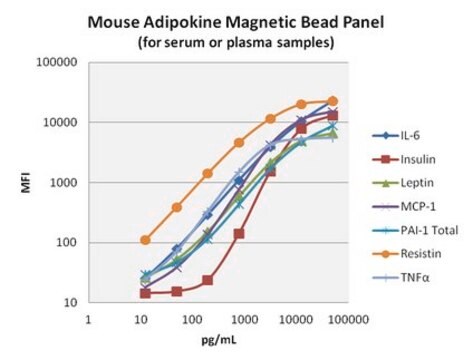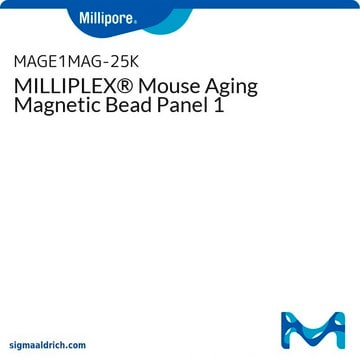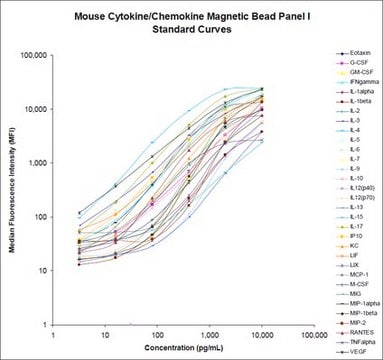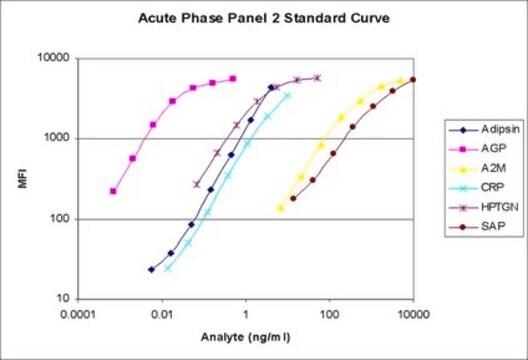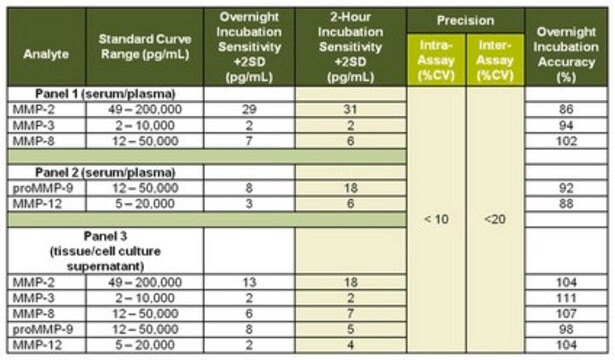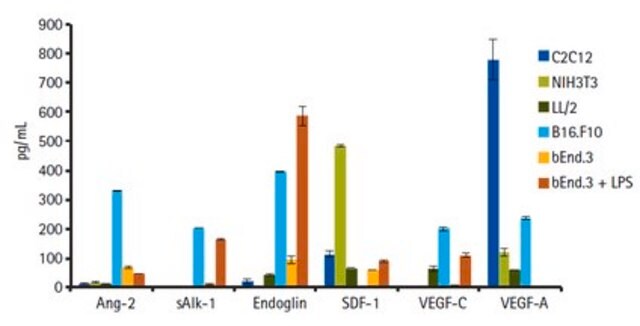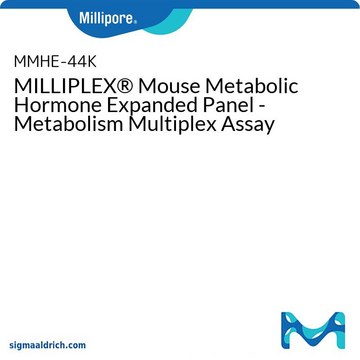MMYOMAG-74K
MILLIPLEX® Mouse Myokine Magnetic Bead Panel
Inflammation/Immunology Bead-Based Multiplex Assays using the Luminex technology enable the simultaneous analysis of multiple myokine and cytokine biomarkers in mouse serum and plasma samples.
About This Item
Prodotti consigliati
Livello qualitativo
Reattività contro le specie
mouse
Produttore/marchio commerciale
Milliplex®
assay range
accuracy: 3-40,000 pg/mL
(Osteocrin)
standard curve range: 0.6-9,000 pg/mL
(BDNF)
standard curve range: 128-2,000,000 pg/mL
(Osteonectin (SPARC))
standard curve range: 16-250,000 pg/mL
(Oncostatin M)
standard curve range: 22-350,000 pg/mL
(EPO)
standard curve range: 256-4,000,000 pg/mL
(Myostatin)
standard curve range: 26-400,000 pg/mL
(26Irisin)
standard curve range: 3-40,000 pg/mL
(LIF)
standard curve range: 3-40,000 pg/mL
(Osteocrin/Musclin (OSTN))
standard curve range: 48-750,000 pg/mL
(IL-15)
standard curve range: 5-75,000 pg/mL
(FGF21)
standard curve range: 9-140,000 pg/mL
(IL-6)
inter-assay cv: <15%
intra-assay cv: <10%
tecniche
multiplexing: suitable
Metodo di rivelazione
fluorometric (Luminex xMAP)
Condizioni di spedizione
ambient
Categorie correlate
Descrizione generale
MILLIPLEX® Mouse Myokine Panel is a 12-plex kit to be used for the simultaneous quantification of any or all of the following analytes in serum, plasma, and tissue culture samples: Brain-derived Neurotrophic Factor (BDNF), Erythropoeitin (EPO)*, Fibroblast Growth Factor 21 (FGF21), Follistatin-Like Protein 1 (FSTL-1), IL-6, IL-15, Irisin, Leukemia Inhibitory Factor (LIF), Myostatin (MSTN / GDF8), Oncostatin M (OSM), Osteocrin/Musclin (OSTN), Osteonectin (SPARC).
*Only available for cells culture samples.
This kit uses a 96-well format, contains a lyophilized standard cocktail, two internal assay quality controls and can measure up to 38 samples in duplicate.
The Luminex® xMAP® platform uses a magnetic bead immunoassay format for ideal speed and sensitivity to quantitate multiple analytes simultaneously, dramatically improving productivity while conserving valuable sample volume.
Panel Type: Metabolism
Applicazioni
- Analytes: Brain Derived Neurotrophic Factor (BDNF), Erythropoietin (EPO), Fibroblast Growth Factor 21 (FGF-21), Follistatin-like Protein 1 (FSTL1), IL-6, IL-15, Irisin, Leukemia Inhibitory Factor (LIF), Myostatin (MSTN/GDF8), Oncostatin M (OSM), Osteocrin (OSTN/Musclin), Osteonectin (SPARC)
- NOTES: BDNF - Substantial amounts of BDNF are stored in circulating platelets and subsequently released upon platelet activation. Therefore, platelet-poor plasma is critical to ensure accurate measurement of circulating levels of BDNF. OSM - While OSM is barely detectable in the serum/plasma of healthy subjects, a slight increase can be observed in certain disease states. Higher measurements in cell culture samples have also been reported. Erythropoeitin (EPO) is for tissue culture samples only and cannot be combined with other analytes in this panel when measuring serum or plasma.
- Recommended Sample Type: Mouse serum, plasma, or cell/tissue culture supernatants or lysates
- Recommended Sample Dilution: 25 μL per well of 1:2 diluted serum or plasma; cell/tissue culture samples may require dilution in an appropriate control medium.
- Assay Run Time: For greater sensitivity an overnight incubation is recommended, (16-18 hours) at 2-8°C. Alternatively, incubate for 2 hours at room temperature (20-25°C).
- Research Category: Metabolism
- Research Subcategory: Obesity, Metabolic Disorders, Inflammation
Caratteristiche e vantaggi
Altre note
Note legali
Avvertenze
Danger
Indicazioni di pericolo
Classi di pericolo
Acute Tox. 4 Dermal - Acute Tox. 4 Inhalation - Acute Tox. 4 Oral - Aquatic Chronic 2 - Eye Dam. 1 - Skin Sens. 1 - STOT RE 2
Organi bersaglio
Respiratory Tract
Classe di pericolosità dell'acqua (WGK)
WGK 3
Certificati d'analisi (COA)
Cerca il Certificati d'analisi (COA) digitando il numero di lotto/batch corrispondente. I numeri di lotto o di batch sono stampati sull'etichetta dei prodotti dopo la parola ‘Lotto’ o ‘Batch’.
Possiedi già questo prodotto?
I documenti relativi ai prodotti acquistati recentemente sono disponibili nell’Archivio dei documenti.
Il team dei nostri ricercatori vanta grande esperienza in tutte le aree della ricerca quali Life Science, scienza dei materiali, sintesi chimica, cromatografia, discipline analitiche, ecc..
Contatta l'Assistenza Tecnica.